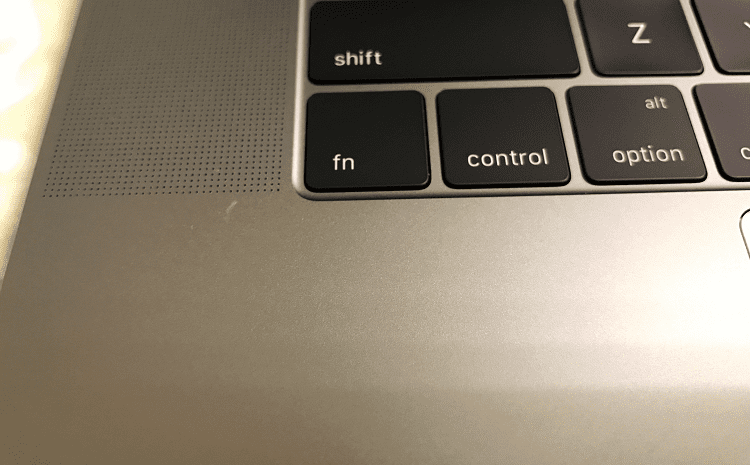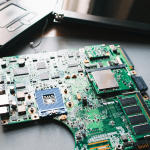How do you remove the scratches on your laptop once you bought it? Whether you own a high-end brand or a cheap plastic model, scratches can quickly become a common occurrence.
It doesn’t matter if you use your laptop for homework, social media, or browsing the web–chances are you’ll take a few hard hits along the way.
Hard hits, including this one, can leave a scratch on your laptop. Fortunately, you can remove this scratch with just a few simple, easy tricks!
Types Of Scratches That You Need to Look After
Contents
We’ll go further into detail on how to remove scratches in the next section.
But there is a basic method you can use to try to remove different types of scratches. Start by covering the whole laptop with a cloth to prevent any smears.
Then, using a soft cloth or a cotton bud, dust up the scratch. Cotton buds are perfect for this because they’re very soft and won’t damage the laptop.
There’s a good range of home cleaning products available, too. Be careful not to use abrasive materials, as this could worsen the scratch.
However, there are some other things to learn in this field, such as what causes scratches to occur.
Major Scratches
Major scratches are more difficult to disguise than a hairline scar or one that’s shallow. The best way to cover up a scratch is to buff the area with actual wax or fine polish.
Rolite Metal Polish is the finest metal polish you can buy.
You will find its aluminum oxide crystals are the strongest kind around and their formula is specially designed to restore metals to their original shine.
Before applying Rolite Metal Polish, the surface should be clean and free of any oils, greases, or waxes.
First, clean the surface with an alcohol-ammonia solution using a cotton bud or paper towel.
Next, apply Rolite Metal Polish to the scratch using circular motions with light pressure.
Minor scratches
Minor scratches are those on the laptop itself rather than on the surface of your laptop. They can be easily and rapidly repaired using methods like polishing it with sandpaper.
Scratches that stay on the laptop’s exterior can eventually become noticeable.
The external surface will eventually lose its luster, and it can become discolored. When you notice this discoloration, you should clean the laptop’s exterior with clean water and a soft cloth.
It’s an unusual way to deal with a scratch, but spraying some toothpaste on it might reduce the friction when cleaning the scratch.
Always use a microfiber cloth when buffing a laptop. The microfiber cloth is soft and won’t damage the surface of the laptop.
A scratch remover is also a viable method for removing scratches from different types of fabrics.
How To Remove Scratches From an Aluminum Laptop
Use A Laptop Bag
It’s also a good idea to store your laptop bag in a location that is far from anything that your kids might accidentally knock over, such as your lap to avoid scratches.
For example, if you use a laptop bag to keep certain accessories separate and avoid damaging them, you will avoid having to replace or fix them in the near future.
When transporting your laptop, you should buy a case that has a protective cover that closes with a zipper.
This way, you can put your laptop inside of the case and put it inside of a backpack or other bag, instead of carrying your laptop in your hands.
Avoid placing anything else inside your laptop bag, including keys, your cell phone, or even the laptop charger.
Instead, you should invest in a laptop bag with several pockets so that you can store all of your essentials without worrying about damaging your computer’s screen.
Instead, choose a laptop bag with several pockets so that you’re able to keep your essentials separated from your computer.
Use Baking Soda
Baking soda may be used in the same ratios, but the smaller amount of baking soda may create a paste that is difficult to apply to small crevices.
It may be incredibly effective, but if you use it in excess, you could very well ruin your laptop.
To achieve the greatest results, combine baking soda with a few drops of water during the massage process.
Remove excess paste by buffing the surface with a soft microfiber towel or cloth. Its effectiveness will last several days, depending on the amount of paste used.
Use two parts baking soda and one part water to create a paste. Fill a spray bottle with this solution and spray it in the area of the scratch.
You may make a paste by adding a small amount of water and baking soda to a small dish.
Apply the paste to the scrapes, and use a clean, dry cloth to wash it away.
Similar to how you’d use glass cleaner on window glasses, you can use a baking soda paste to remove the scuffs from your aluminum laptop.
Use Toothpaste
Simply apply a tiny quantity of toothpaste to a microfiber cloth and gently wipe away the scratch.
A small amount of toothpaste will make light work of this task, so it’s important to use just the right amount of toothpaste.
Gently rub the toothpaste into the affected area and watch as the scratch disappears.
Gently apply toothpaste to the scrape and rub it gently. Rub the surface during the whole treatment.
Simply wash your laptop with a soft cloth, dry it, and Polish it using a microfiber cloth to remove the toothpaste residue and scratches.
Use Scratch removers
This is perhaps the most apparent and effective way.
Once you’ve acquired a solution like this, all you have to worry about is that you’ll be immediately able to rearrange your laptop, which will save you a lot of time.
Apply some pressure to the scratch remover, and it will sink in to the spot.
Some strains can look hazy, or even invisible, after a few moments. However, this will take time to completely dry.
Keep in mind that these solutions don’t remove scratches completely, but they do a great job of making the laptop look a lot newer than it was before.
Scratch removers are also helpful for uncolored, deep scratches, but they’re not great for light-colored or small scratches.
How to Remove Scratches From A Plastic Laptop
Use Sandpaper Sheets
Consider obtaining some sheets of sandpaper in various fineness levels so you can create designs or patterns whenever you like.
To avoid inflicting more harm to your laptop’s surface, you should only purchase the sandpaper sheets that are suggested by the manufacturer.
- Apply mild pressure and move it in circles to start removing the scratches.
- After that, wipe the sheet clean with a dry towel and you’re done!
- If there are still scratches visible, we recommend using the finer sandpaper sheet to remove them.
- Consider ending by adding a layer of clear coat on top of the surface to protect the surface against any scratches.
- This will assist to improve the durability of your laptop and safeguard it from further scratches.
Use Plastic Polish
Plastic polish, which is commonly accessible in household cleaning products, can be used to polish out scratches on plastic laptops.
Dish soap and warm water are mixed into a solution using a bowl. The solution should be used on a clean microfiber cloth.
The cloth is applied to the laptop’s surface in circular motions. Use more polish if necessary.
To remove scratches using plastic polish is simple; however, the process may take some practice.
- Make a solution by combining 1 tablespoon of dish soap in 1 cup warm water. Dip a clean microfiber towel into the solution and wipe off the lid of your laptop. Avoid cleaning the LCD screen of your laptop with this method.
- Clean the surfaces of your laptop using the solution and wait. After the solution dries, wipe off excess polish with a paper towel.
- Using a microfiber cloth, wipe off any residual polish.
- Apply a tiny quantity of polish to a clean microfiber cloth. Gently apply the polish to the affected areas and massage it in circular movements to remove dirt and debris. Rinse the cloth and wipe off any excess polish. Wipe the laptop with a clean towel to make sure it is completely dry.
- You may add water to the mixture if the surface feels dry.
- Before cleaning your laptop lid, give it a moment to absorb the solution.
Conclusion
Because we’ve previously gone through all options, we can be sure that they all work. Providing that care, you shouldn’t have any problems at all.
I’ve also offered some suggestions on how to prevent greasy fingerprints and smudges from building up.
If you’ve tried these tactics, but still have scratches, try brushing them carefully with a microfiber cloth.
The likelihood of getting scratches is lower, and if it’s by any chance, you can use the same process to remove them.
Use a good laptop bag on a frequent basis, to keep the hardware safe.
You won’t want to be wrapped with a laptop that’s covered in dirt and grime.
You’ll also want to clean your computer on a regular basis. Try to keep it away from food and liquids as much as possible.
Regardless, you know best the amount of time that you spend in front of your computer. This is nothing to be ashamed of.
You may also use a screen protector to repel stains on the laptop’s screen.
This should be enough to keep your laptop safe.




